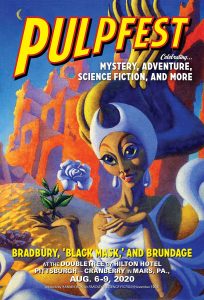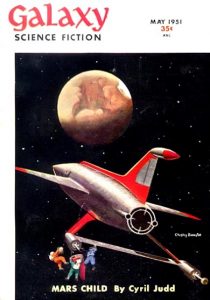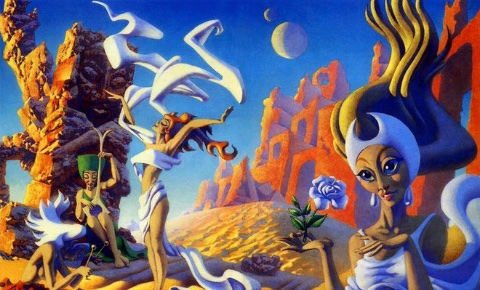 Since the dawn of civilization, humankind has looked toward the heavens for renewal and redemption. From the Ancient Greeks and Romans — who believed the stars and planets to be their gods and heroes — through the utopian writers of the late nineteenth century and Edgar Rice Burroughs’ John Carter gazing toward a red star on the horizon . . .
Since the dawn of civilization, humankind has looked toward the heavens for renewal and redemption. From the Ancient Greeks and Romans — who believed the stars and planets to be their gods and heroes — through the utopian writers of the late nineteenth century and Edgar Rice Burroughs’ John Carter gazing toward a red star on the horizon . . .
As I gazed upon it, I felt a spell of overpowering fascination — it was Mars, the god of war, and for me, the fighting man, it had always held the power of irresistible enchantment. As I gazed at it on that far-gone night it seemed to call across the unthinkable void, to lure me to it, to draw me as the lodestone attracts a particle of iron. . . .
Even in H.G. Wells’s apocalyptic THE WAR OF THE WORLDS and its more recent sequels including Stephen Baxter’s THE MASSACRE OF MANKIND (2017), humanity is drawn to the heavens . . .
If the Martians can reach Venus, there is no reason to suppose that the thing is impossible for men, and when the slow cooling of the sun makes this earth uninhabitable, as at last it must do, it may be that the thread of life that has begun here will have streamed out and caught our sister planet within its toils. Dim and wonderful is the vision I have conjured up in my mind of life spreading slowly from this little seed bed of the solar system throughout the inanimate vastness of sidereal space.
The countless alien invasion and bug-eyed-monster pulp yarns inspired by Wells’s novel likewise end with humankind triumphant and gazing toward the heavens or the next galaxy with a sense of wonder.
As the pulps gave way to digest magazines and paperback books, the fiction of Mars also changed. Stepping away from the largely romantic adventures found in the Barsoom of Edgar Rice Burroughs and the monster yarns, it turned toward the frontier notions found in Ray Bradbury’s THE MARTIAN CHRONICLES.
Although the Mars of this 1950 fix-up novel is a dead and haunted planet, it still beckoned to readers and other writers. Despite an oftentimes more realistic approach to the red planet, a sense of wonder and romance is very much present in the Martian fiction of the 1950s and beyond.
Bradbury’s influence is readily seen in stories such as Clifford D. Simak’s “Seven Came Back” (AMAZING STORIES, October 1950), Robert A. Heinlein’s STRANGER IN A STRANGE LAND (1961), J.G. Ballard’s “The Time-Tombs” (IF, March 1963), Roger Zelazny’s “A Rose for Ecclesiastes” (THE MAGAZINE OF FANTASY AND SCIENCE FICTION, November 1963), John Varley’s “In the Hall of the Martian Kings” (THE MAGAZINE OF FANTASY AND SCIENCE FICTION, February 1977), Ian McDonald’s DESOLATION ROAD (1988), and even Leigh Brackett‘s adventurous “Black Amazon of Mars” (PLANET STORIES, March 1951) and “The Last Days of Shandakor” (STARTLING STORIES, April 1952). The human newcomers are redeemed by accepting Mars, similar to the family in Ray Bradbury’s “The Million Year Picnic” (PLANET STORIES, Summer 1946), the last story in THE MARTIAN CHRONICLES.
The Martians were there — in the canal — reflected in the water. Timothy and Michael and Robert and Mom and Dad. The Martians stared back up at them for a long, long silent time from the rippling water. . . .
 In the more realistic portrayals of Mars found in Arthur C. Clarke’s THE SANDS OF MARS (1951), Cyril Kornbluth’s and Judith Merrill’s OUTPOST MARS (originally serialized as “Mars Child” in GALAXY, May – July, 1951, as by Cyril Judd), Isaac Asimov’s “The Martian Way,” (GALAXY, November 1952), Walter M. Miller’s “Crucifixus Etiam” (ASTOUNDING SCIENCE FICTION, February 1953), Theodore Sturgeon’s “The Man Who Lost the Sea” (THE MAGAZINE OF FANTASY AND SCIENCE FICTION, October 1959), James Blish’s WELCOME TO MARS (originally serialized as “The Hour Before Earthrise” in IF, July – September 1966), Frederick Turner’s A DOUBLE SHADOW (1978), Greg Bear’s MOVING MARS (1993), Ben Bova’s MARS (1992) and RETURN TO MARS (1999), Kim Stanley Robinson’s award-winning Mars trilogy — RED MARS (1992), BLUE MARS (1993), and GREEN MARS (1996) — Geoffrey A. Landis’s MARS CROSSING (2000), and even Andy Weir’s survival story, THE MARTIAN (2011) and the young adult anthology, THE CALLAHAN KIDS: TALES OF LIFE ON MARS (2013), the romance and wonder of the Martian frontier and the redemption of humanity are very much present for those who accept it.
In the more realistic portrayals of Mars found in Arthur C. Clarke’s THE SANDS OF MARS (1951), Cyril Kornbluth’s and Judith Merrill’s OUTPOST MARS (originally serialized as “Mars Child” in GALAXY, May – July, 1951, as by Cyril Judd), Isaac Asimov’s “The Martian Way,” (GALAXY, November 1952), Walter M. Miller’s “Crucifixus Etiam” (ASTOUNDING SCIENCE FICTION, February 1953), Theodore Sturgeon’s “The Man Who Lost the Sea” (THE MAGAZINE OF FANTASY AND SCIENCE FICTION, October 1959), James Blish’s WELCOME TO MARS (originally serialized as “The Hour Before Earthrise” in IF, July – September 1966), Frederick Turner’s A DOUBLE SHADOW (1978), Greg Bear’s MOVING MARS (1993), Ben Bova’s MARS (1992) and RETURN TO MARS (1999), Kim Stanley Robinson’s award-winning Mars trilogy — RED MARS (1992), BLUE MARS (1993), and GREEN MARS (1996) — Geoffrey A. Landis’s MARS CROSSING (2000), and even Andy Weir’s survival story, THE MARTIAN (2011) and the young adult anthology, THE CALLAHAN KIDS: TALES OF LIFE ON MARS (2013), the romance and wonder of the Martian frontier and the redemption of humanity are very much present for those who accept it.
One can even discern wonder and redemption in the twisted realities of Frederick Brown’s comical “Martians Go Home” (ASTOUNDING SCIENCE FICTION, September 1954), Kurt Vonnegut’s THE SIRENS OF TITAN (1959), and Philip K. Dick’s MARTIAN TIME-SLIP (originally serialized as “All We Marsmen” in WORLDS OF TOMORROW, August – December 1963) and THE THREE STIGMATA OF PALMER ELDRITCH (1964).
These are just a few of the many fine tales of Mars and Martians to be published since the release of THE MARTIAN CHRONICLES over seventy years ago. Please join PulpFest 2020 on Friday, August 7, as we welcome Albert Wendland to discuss modern visions of the planet Mars at the DoubleTree by Hilton Hotel Pittsburgh – Cranberry in Mars, Pennsylvania. It’s the third and final segment of our series exploring “Visions of Mars,” celebrating the 100th anniversary of the birth of author Ray Douglas Bradbury.
(Pictured here are William Lampkin’s modified version of Hannes Bok’s wrap around cover-art for THE MAGAZINE OF FANTASY AND SCIENCE FICTION for November 1963, as well as GALAXY SCIENCE FICTION for May 1951 with front cover art by Chesley Bonestell.
To learn more about the fiction of Mars, we recommend the Mars entry in the online SFE: THE SCIENCE FICTION ENCYCLOPEDIA (which also includes a look at Mars in film and television), Book Riot’s MARS IN FICTION: A TIMELINE, 21 BEST MARS SCIENCE FICTION BOOKS on The Best Sci Fi Books, goodreads’s “100 Science Fiction and Fantasy Books set on or about Mars,” and Mike Ashley’s “A Brief History of Sci-Fi’s Love Affair With the Red Planet,” a somewhat abridged version of his introduction to his anthology, LOST MARS, a collection of “Stories from the Golden Age of the Red Planet.”
Albert Wendland has made a career out of his life-long interests in science fiction — and photography, art, film, and travel. He teaches popular fiction, literature and writing at Seton Hill University, where he was director of its MFA in Writing Popular Fiction (the first program with exclusive attention to genre writing). His science-fiction “space noir” novel from Dog Star Books, THE MAN WHO LOVED ALIEN LANDSCAPES, was a starred pick-of-the-week by PUBLISHER’S WEEKLY. It was followed by the prequel, IN A SUSPECT UNIVERSE, described as “planetary-romance noir.” Dog Star just published a book of his poetry supposedly written by the protagonist of both novels, TEMPORARY PLANETS FOR TRANSITORY DAYS, on both interstellar and terrestrial subjects. He’s also written and published a study of science fiction, a chapter in MANY GENRES, ONE CRAFT, a poem in DRAWN TO MARVEL: POEMS FROM THE COMIC BOOKS, and several articles on science fiction and writing. He enjoys landscape photography, astronomy, film studies, graphic novels, and the “sublime.”
For a look at our entire programming schedule, please click the Programming button below the PulpFest banner on our home page.)






